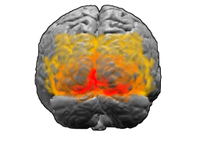
Photo from wikipedia
Visual Abstract Visual space embodies all visual experiences, yet what determines the topographical structure of visual space remains unclear. Here we test a novel theoretical framework that proposes intrinsic lateral… Click to show full abstract
Visual Abstract Visual space embodies all visual experiences, yet what determines the topographical structure of visual space remains unclear. Here we test a novel theoretical framework that proposes intrinsic lateral connections in the visual cortex as the mechanism underlying the structure of visual space. The framework suggests that the strength of lateral connections between neurons in the visual cortex shapes the experience of spatial relatedness between locations in the visual field. As such, an increase in lateral connection strength shall lead to an increase in perceived relatedness and a contraction in perceived distance. To test this framework through human psychophysics experiments, we used a Hebbian training protocol in which two-point stimuli were flashed in synchrony at separate locations in the visual field, to strengthen the lateral connections between two separate groups of neurons in the visual cortex. After training, participants experienced a contraction in perceived distance. Intriguingly, the perceptual contraction occurred not only between the two training locations that were linked directly by the changed connections, but also between the outward untrained locations that were linked indirectly through the changed connections. Moreover, the effect of training greatly decreased if the two training locations were too close together or too far apart and went beyond the extent of lateral connections. These findings suggest that a local change in the strength of lateral connections is sufficient to alter the topographical structure of visual space.
Journal Title: eNeuro
Year Published: 2017
Link to full text (if available)
Share on Social Media: Sign Up to like & get
recommendations!